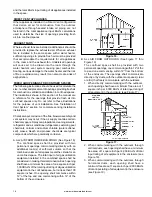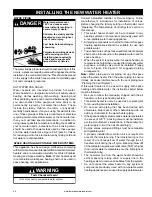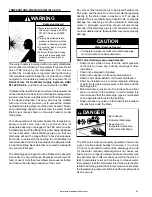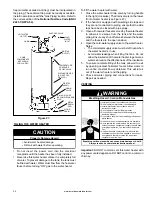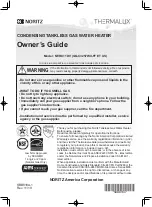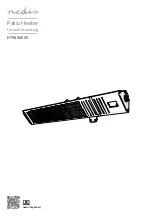
FACTS TO CONSIDER ABOUT THE LOCATION
Carefully choose an indoor location for the new water
heater because the placement is a very important
consideration for the safety of the occupants in the building
and for the most economical use of the appliance. This
water heater is not for use in manufactured (mobile) homes
or outdoor installation.
Whether replacing an old water heater or putting the water
heater in a new location, the following critical points must
be observed:
1. Select a location indoors as close as practical to
the vent termination or location to which the water
heater vent piping is going to be connected, and as
centralized with the water piping system as possible.
2. Selected location must provide adequate clearances
for servicing and proper operation of the water heater.
3. Ensure the area has a continuous supply of air for
combustion, dilution and ventilation.
4. Avoid locations that could cause the water heater to
freeze from outside air.
5. Selected location must provide access to a properly
grounded electrical branch circuit. A dedicated circuit
is preferred. Do not use a GFI outlet.
6. Avoid locations that expose the water heater to direct
sunlight.
7. Keep combustibles such as boxes, magazines,
clothes, etc., away from the water heater area.
Important:
Do not use an extension cord to connect the
water heater to an electrical outlet.
Important:
this heater has special venting requirements
when installed in areas where the ambient temperatures
exceed 110°F (see “High Ambient Temperature
Installations”).
•
All water heaters eventually leak.
•
Do not install without adequate drainage.
Property Damage Hazard
CAUTION
Installation of the water heater must be accomplished in
such a manner that if the tank or any connections should
leak, the
fl
ow of water will not cause damage to the
structure. For this reason it is not advisable to install the
water heater in an attic or upper
fl
oor. In all cases, a metal
drain pan should be installed under the water heater. Metal
drain pans are available at your local hardware store. Such
a metal drain pan must have a clearance of at least 1”
greater than any point on the water heater’s outer jacket
and must be piped to an adequate drain. The pan must
have a maximum depth of 1.75”.
Water heater life depends upon water quality, water
pressure and the environment in which the water heater
is installed. Water heaters are sometimes installed in
locations where leakage may result in property damage,
even with the use of a metal drain pan piped to a drain.
However, unanticipated damage can be reduced or
prevented by a leak detector or water shut-off device used
in conjunction with a piped metal drain pan. These devices
are available from some plumbing supply wholesalers
and retailers, and detect and react to leakage in various
ways:
•
Sensors mounted in the metal drain pan that trigger an
alarm or turn off the incoming water to the water heater
when leakage is detected.
•
Sensors mounted in the metal drain pan that turn off
the water supply to the entire building when water is
detected in the metal drain pan.
•
Water supply shut-off devices that activate based on
the water pressure differential between the cold-water
and hot-water pipes connected to the water heater.
•
Devices that will turn off the gas supply to a gas water
heater while at the same time shutting off its water
supply.
STORAGE OF FLAMMABLE LIQUIDS
Flammable liquids (such as gasoline, solvents, propane
(LP or butane, etc.) and other substances (such as
adhesives, paints, etc.) emit
fl
ammable vapors which can
be ignited by a gas water heater’s hot surface igniter (HSI)
or main burner. The resulting
fl
ashback and
fi
re can cause
death or serious burns to anyone in the area.
This water heater is equipped with a FV (Flammable Vapor)
sensor for detecting the presence of
fl
ammable vapors.
When the sensor detects those vapors, the unit will shut
down and not operate. Should this happen, please refer
to the “Troubleshooting Guidelines” section of this manual.
Even though this water heater is a
fl
ammable vapors
ignition resistant (FVIR) water heater and is designed to
reduce the chances of
fl
ammable vapors being ignited,
gasoline and other
fl
ammable substances should never
be stored or used in the same vicinity or area containing a
gas water heater or other open
fl
ame or spark producing
appliance. Examples of such locations are garages,
storage and utility areas.
The water heater must be located and/or protected so it is
not subject to physical damage by a moving vehicle.
LOCATING THE NEW WATER HEATER
www.americanwaterheater.com
15


















